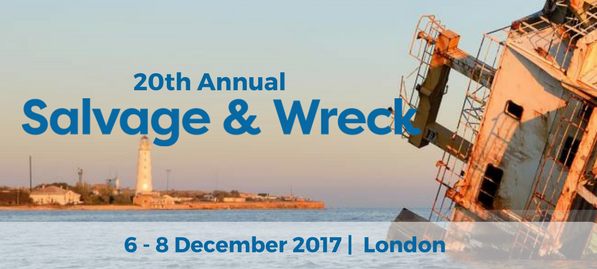Top 3 Takeaways from Salvage & Wreck Asia 2017

Good turnout today for #SalvageAsia event in SG today @NavigateResp is pleased to be speaking !thanks for the invite! pic.twitter.com/kIG4aGlr6T
— Navigate Response (@NavigateResp) September 6, 2017
With changing market outlooks for the salvage and wreck removal industry, this year’s Salvage & Wreck Asia conference had a lot to discuss.
What will the industry do with the declining number of LOF contracts? Why is effective social media management so important during emergency responses? How does one assess the environmental risk wrecks might pose? How could technology improve salvage operations?
These questions were only some of the important considerations raised at Salvage & Wreck Asia this year and here is what we learnt about them:
1. New Contracts on the Rise
One thing the salvage industry has always relied on is the use of Lloyd’s Open Form (LOF), which ensured that salvors were paid fair rates for challenging salvage jobs. In recent years, we have seen a sharp decline in the use of LOF contracts, and concerns that this will deal a crippling blow to the industry have not escaped us.
‘LOF is still the best option but changes are inevitable’ #SalvageAsia
— KNect365 Maritime (@KNectMaritime) September 5, 2017
Alternative contracts, however, will not put an end to the salvage industry. Thanks to Harry Hirst (Master Mariner and Partner at Ince & Co), Johan Wong (Partner at Thomas Cooper LLP), and Toby Stephens (Partner at HFW), Salvage & Wreck Asia, attendees learned how to get the most out of their contracts.
2. The Power of Social Media
As the maritime sector is catching up with new technologies, the salvage industry needs to embrace the power of social media as a key component of emergency response strategy during a casualty. Speaking at Salvage & Wreck Asia, Edward Ion (Managing Partner of Navigate Response Asia) brought over 20 years of experience in media management to our attendees.
‘The industry is not well prepared for the impact of social media during an incident and ship owners are very nervous’ says Ion #SalvageAsia
— KNect365 Maritime (@KNectMaritime) September 5, 2017
‘If you don’t have a social media policy in place, expect trouble. Common sense will go out of the window quickly in a crisis’ #SalvageAsia
— KNect365 Maritime (@KNectMaritime) September 5, 2017
Are there any casualties? How much of the cargo has been saved? What is happening with the wreck? However tedious it might be, going on Twitter to inform the world of your work not only increases the chances of being noticed, but also shows transparency and builds trust. With Ion’s knowledge passed on to attendees, salvors can be ready for their next challenge: an updated emergency response strategy.
3. The Environmental Impact
‘There are approx. 8,500 wrecks worldwide, with up to 20 million metric tonnes of oil on board’ claims Kirby. #SalvageAsia
— KNect365 Maritime (@KNectMaritime) September 6, 2017
Although the world of shipping is being pressured to find alternative fuels to HFO, sinking vessels can still have the potential to cause serious pollution. Mark Kirby (Programme Director of the Oil & Gas Emergency Response at the Centre for Environment, Fisheries and Aquaculture Science – CEFAS) discussed the matter in depth at Salvage & Wreck Asia. Before wreck removal, risk assessments need to be taken to avoid incidents. Even carrying out the assessments can pose dangers, but with technology like 3D scanning, future operations will be much safer for salvors and the environment.
'A great deal of uncertainty remains regarding the pollution risks posed by wrecks worldwide' says Kirby. #SalvageAsia
— KNect365 Maritime (@KNectMaritime) September 6, 2017
However, there is still “a great deal of uncertainty” regarding pollution risks posed by wrecks worldwide. Therefore, it is essential that salvage operators keep on innovating and improving their techniques to make the salvage and wreck removal industries thrive again.
Keep the conversation going! Learning is the next step in any industry’s evolution.
We’d hereby like to thank our speakers for coming and sharing their expertise on such a wide range of interesting topics.
We’d also like to thank our sponsors, without whom this event could not have happened.
Don’t forget to keep in touch! Visit us in London this December for another fantastic Salvage & Wreck Conference!
